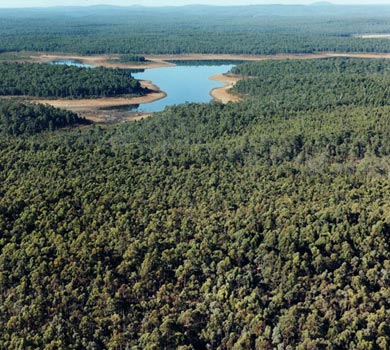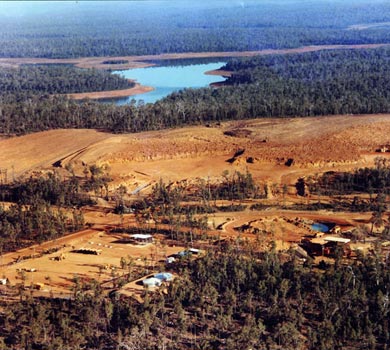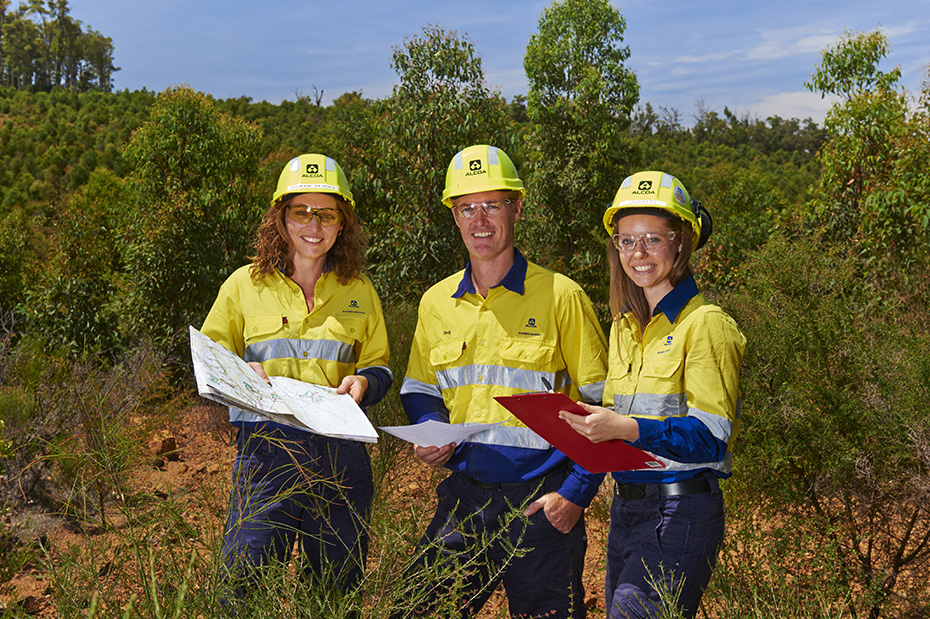Overview
Alcoa World Alumina Australia operates two bauxite mines at Willowdale and Huntly in the Darling Range of southwestern Australia, 80 – 140 kilometers south of Perth. The mine pits range in size from one hectare to tens of hectares. Alcoa has been rehabilitating its bauxite mines since 1966; today some 550 hectares are mined and rehabilitated annually. The technology of rehabilitation has been improved continuously over the years – from plantations of exotic pine trees to a sophisticated state-of-the-art rehabilitation program. Alcoa’s aim after bauxite mining in these areas is to re-establish all the pre-existing land uses of the forest: conservation, timber production, water production and recreation. Re-establishing a jarrah forest on the mined areas that is as similar to the original forest as possible was determined to be the best way to achieve this goal.
Alcoa has been successful in reaching its goal. In 2000, the company documented that, on average, 100 per cent of the indigenous plant species found in representative jarrah forest sites would also be found in a 15-month-old rehabilitation, with at least 20 per cent of those found being from a recalcitrant species priority list. The goal now is to maintain this good record and thus the botanical richness of mined areas after mining operations have ceased.
Quick Facts
Project Location:
-32.6225989, 116.0592421
Geographic Region:
Australia & New Zealand
Country or Territory:
Australia
Biome:
Temperate Forest
Ecosystem:
Temperate Forest - Mixed
Area being restored:
10,500 Hectares
Project Lead:
Alcoa World Alumina Australia
Organization Type:
Private Company
Location
Project Stage:
Implementation
Start Date:
1966-01-01
End Date:
2007-12-01
Primary Causes of Degradation
Mining & Resource ExtractionDegradation Description
There are currently approximately 1.8 million ha of intact Jarrah forest in Western Australia, about 65% of the total compared to pre-European settlement. Currently, Alcoa mines and rehabilitates 500-600 ha of this forest each year at open-cut mines located between 55 and 130 km south of Perth (pop. 1,500,000), the capital city. Because of the close proximity to the capital, bauxite mining is being done on lands subject to multiple usage. These uses include urban water catchment, timber production, and recreation.
Bauxite mining occurs in isolated pods of 1 – 100 ha in area, averaging 10 – 20 ha. Usable timber is extracted by contractors prior to mining. After timber harvest, the mining sequence involves: clearing the remaining vegetation, removing the soil, blasting the cemented bauxite layer or ripping it with a bulldozer, and removing and crushing the bauxite before transporting it to the refineries.
Reference Ecosystem Description
Containing at least 784 plant species, the jarrah forest is renowned for its diverse flora. It is one of the most plant-species-rich forests in the world outside of tropical rainforests. Alcoa’s research and monitoring has shown that there are approximately 300 plant species among the vegetation types in areas mined by the company.
The jarrah forest is classified as medium open forest on the basis of height and canopy density (10-30 m in height, 30-70% canopy cover). It is dominated by the jarrah tree, and marri (Corymbia calophylla) also occupies a large part of this area. In contrast to the floristic paucity of the tree strata, the jarrah forest floor is covered by a diverse sub-shrub and shrub layer to 2 m in height. The vegetation superficially appears uniform. More realistically, it forms a complex multi-dimensional continuum of overstory and understory species responding to a number of changing environmental variables.
The region is a centre of endemism for plants (e.g. Eucalyptus marginata), has a locally patchy biota despite the geological and geomorphic uniformity of the lateritic plateau, and is a refugia for many threatened species of flora and fauna. Rare or threatened species in the jarrah forest ecosystem include: orchids (Drakaea confluens, Caladenia bryceana subsp bryceana), birds (Muirs Corella, Western Whipbird, Western Bristlebird, Noisy Scrub-Bird), mammals (Potorous tridactylus gilbertii, and Isoodon obesulus, Dasyurus geoffroii, Parantechinus apicalis, Phascogale calura, P. tapoatafa, Setonix brachyurus, Myrmecobius fasciatus, Bettongia penicillata ogilbyi, Macropus eugenii derbianus and Pseudocheirus occidentalis), frogs (critically endangered Geocrinia alba and Geocrinia vitellina, Spicospina flammocaerulea) and the Baumea reed beds of freshwater wetland in forest areas.
Project Goals
Alcoa’s general rehabilitation objective, after mining activities cease in a particular area, is to re-establish a self-sustaining jarrah forest ecosystem, planned to enhance or maintain water, timber, recreation, and conservation values.
A more specific target set for each restoration site is that “The average number of indigenous plant species in 15 month old rehabilitation is 100% of the number found in representative jarrah forest sites, with at least twenty percent of these from the recalcitrant species priority list.”
Monitoring
The project does not have a monitoring plan.
Stakeholders
Most research and rehabilitation activities are funded and carried out solely by Alcoa, although some projects have been performed with the involvement of universities and other research organizations.
Description of Project Activities:
The ï¬rst step in the rehabilitation process is to batter down the pit walls and landscape the mines to blend into the surrounding forest topography. The overburden and topsoil are returned in the correct sequence, and the pit is then contour ripped to approximately 1.5 m using a winged ripping tine. Ripping with the winged tine encourages water inï¬ltration, reduces the risk of erosion, and relieves soil compaction that could restrict root growth.
Following the earthworks, the areas are seeded with a mix that includes the two dominant tree species and approximately 50 to 90 species of the ground flora. More than two tons of native seed are used annually mine restoration; all of this seed is collected within about 20 km from the mine where it is to be used. Using local or "˜provenance correct' seed ensures the genetic diversity of the restored areas is maintained.
There are many species where seed collecting and subsequent broadcasting is impractical, very expensive or even impossible. For many of these, the natural seed in the returned topsoil is the best re-establishment option. Research has led to the following recommendations to maximize the contribution of the topsoil seed store to restoration:
- Strip and return the soil in the dry season (summer-autumn in this case)
- Direct return the topsoil (don't stockpile it)
- Rip in the dry season (summer-autumn)
- Keep the top layers on the top (double strip and avoid burying topsoil during ripping)
- Screen out some of the inert gravel fraction and apply the "˜concentrated seed fraction' to areas that did not receive fresh topsoil.
Plant species that are not amenable to reestablishment from topsoil or broadcast seed are propagated by tissue culture or cuttings in Alcoa's Marrinup Nursery and planted in winter (200 - 500/ha). Those that are susceptible to grazing are guarded. Finally, 500 kg/ha of a fertilizer mix based on diammonium phosphate with added potassium and micronutrients is applied by helicopter in spring.
Early rehabilitation techniques involved planting exotic pine trees (e.g., Pinus pinaster) or eastern Australian eucalypt species in rows with no understory seeding. Sites rehabilitated after 1976 were seeded with an understory comprising mainly native legume species (e.g., Acacia pulchella, A. urophylla). In the early 1980s, rehabilitation sites were planted with a mix of native and eastern Australian dieback-resistant eucalypt species. It was unknown if jarrah dieback disease (caused by Phytophthora cinnamomi) would kill jarrah trees established in rehabilitated mine pits. However, research showed that the survival rate of jarrah in rehabilitated mine pits was high, irrespective of the presence of P. cinnamomi. Since 1988, a native overstory has been established in rehabilitation sites by seeding the indigenous forest dominants, jarrah and marri.
Ecological Outcomes Achieved
Eliminate existing threats to the ecosystem:
All measured indicators show that our restored areas have the building blocks and processes in place to successfully re-instate the jarrah forest ecosystem. There has been a continuous improvement in recovery results. Paying careful attention to handling and timing of topsoil movement, developing and applying new technology, putting new initiatives in place, and improving the broadcast seed mix and its method of application saw a gradual improvement in species richness in mined plots to over 80% of unmined plots' richness by 1995. By further improving soil handling methods, improved seed technology, and by planting recalcitrant species, the target was exceeded and a value of 101.4% was achieved at Alcoa mines in 2001 restored areas. Late soil ripping in the wet season saw lower richness results for 2002 and 2003, and a very dry year in 2001 produced poor natural soil seedbanks which also affected richness in 2002 and 2003. 2004 achieved 96%, while 2005 again fell to 90% due to closure of a mining region and the subsequent lack of opportunities to carry out direct return of topsoil. 2006 results will be available at the end of 2007.
Factors limiting recovery of the ecosystem:
As seen in the reduced richness measurements in 2002, 2003, and 2005, there are a number of variables that could be seen as factors limiting recovery, at least temporarily. A very dry year in can affect natural soil seedbanks in following years, as can logistical restraints on the timing of soil ripping and topsoil return. Directly returning topsoil to a rehabilitated area greatly increases botanical richness, but planning for direct topsoil return can be complex, and operational constraints can result in topsoil being stockpiled. Part of the challenge is to improve planning processes and to implement plans to maximize the direct return of topsoil. Improvements had to be made at all stages of rehabilitation. This involved refining existing practices, developing new practices, developing better mine planning tools, developing new technology and further increasing environmental commitment.
Socio-Economic & Community Outcomes Achieved
Economic vitality and local livelihoods:
The intact jarrah forest has high conservation and biodiversity value, is the basis of a major sawmilling industry, and is widely used for recreation pursuits.
Considerations for the mining operation directly related to human well-being are water catchment protection, loss of timber production, and impacts on local communities such as noise, dust and access to forest. All of these issues are addressed to some extent by a successful restoration effort.
Key Lessons Learned
Five important components of Alcoa’s approach to restoring the jarrah forest are worth noting:
– Identify opportunities to improve the number of plant species.
– Select research projects. Some projects were major investments, with the involvement of universities and other research organisations; other research took place solely within Alcoa.
– Build the infrastructure and equipment. In the development phase, infrastructure such as a micropropagation laboratory was built, and equipment such as mechanical seeders and large-scale soil screens were designed and constructed.
– Track changes to botanical richness. Monitoring occurred every year using a scientifically based sampling regime.
– Set clear targets. Stating an objective for the rehabilitated areas – to restore a functional jarrah forest ecosystem that matched the pre-mining land uses – was a significant step forward for the company.
The areas restored under this program are still young (mostly less than 30 years old) and full ecosystem restoration may take centuries. However, all measured indicators show that the areas restored under this program have the building blocks and processes in place to successfully re-instate the jarrah forest ecosystem.
Long-Term Management
To measure and monitor botanical richness, Alcoa developed a rigorous, scientifically based sampling system to be performed annually. Each spring, when each rehabilitation area is 15 months old, fifty 80m2 plots are randomly placed at each mine. All local plant species in each plot are identified and counted, and identical control plots in the unmined forest adjacent to each mine are used to make the comparisons against.
Sources and Amounts of Funding
200,000,000 USD Alcoa World Alumina Australia
Other Resources
Dr. John M Koch
Senior Research Scientist
Alcoa World Alumina Australia
Huntly Mine
PO Box 172 Pinjarra WA 6208
ph 08-9530-2340 fax 08-9530-2571
[email protected]
Publications:
Peer reviewed:
#C.D. Grant, D.T. Bell, J.M. Koch. 1996. Implications of seedling emergence to site restoration following bauxite mining in Western Australia. Restoration Ecology 4(2): 146-154.
#Melanie A. Norman, John M. Koch, Carl D. Grant, Tim K. Morald, Samuel C. Ward. 2006. Vegetation Succession After Bauxite Mining in Western Australia. ҬRestoration Ecology 14(2): 278 Р288.
Not peer reviewed:
http://www.alcoa.com/australia/en/info_page/Mine_rehab.asp
http://www.soe.wa.gov.au/
http://www.anra.gov.au/topics/vegetation/assessment/wa/ibra-jarrah-forest.html




